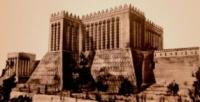You are here
About Varahsha. Muhammad Narshahi.

Trips around the Bukhara region.
“Leave the mosque! Prefer peers!
Where are the Gurias of Taraz, Bukhara?
Live for them!
My god does not love prayers
He made us a love game”
Rudaki Abu Abdullah Jafar.
History of Varakhsha.
Varakhsha (Above Farakhsha), it is very likely that the name of the village is preserved in the name of the Varakhchin well, in the sands of Kimirik-Kum.) - one of the larger villages. First of all, it was not inferior in size to the city of Bukhara, and even more ancient than Bukhara by the time of its foundation.
In some books, instead of Varakhshi, this village is called Rajfandun. There was the residence of the kings; there is also a strong fortress there, because kings strengthened this place several times. The former walls of the village were equal in size to the walls of Bukhara.
There are 12 irrigation canals (irrigation canals) in Rajfaidun or Varakhsha; the village is located inside the Bukhara wall (This refers to the large wall that surrounded Bukhara along with the surrounding villages. See this wall below).
There was also a beautiful palace, the beauty of which became a proverb; It was built by Bukhar-Khudat more than a thousand years ago. Long ago this palace fell into decay and destruction when Hunuk-Khudat resumed it.
After renewal, the palace had time to collapse again, but Bukhar-Khudat Buniyat, the son of Tahshad, in the era of Islam, rebuilt the palace and lived there until it was killed in this palace. Amir Ismail Samani, - may God have mercy on him, - called the residents of this village to his side and told them that he agreed to give 20 thousand dirhem and the wood and material necessary for the construction (besides, part of the building was still intact) so that they remade this palace into a mosque.
But the residents did not agree to this proposal, referring to the fact that their village does not need a mosque and not so much as to build a mosque here. The palace of Buniat existed before the time of Amir Ahmad (This prince did not reign; after his death, one after another, his sons Abdul-Malik (954 - 901) and Mansur (961 - 970) ruled.), Son of Nukh , grandson of Nasr, great-grandson of Ahmad, great-great-grandson of Ismail Samani.
This Amir Ahmad took advantage of the forest from this palace, transported the wooden parts to the city and used them to rebuild his palace at the gates of the Bukhara fortress. In this village there is a bazaar every 15 days, and at the end of the year there is a fair lasting 20 days.
On the 21st day, the new year is celebrated, and this day is called the new year of the farmers, because the farmers of Bukhara start counting from this day (to determine the time of production of famous agricultural works) and rely on this definition of time. New year for magicians comes only in five days.
Enlightener:
Muhammad Narshahi. "History of Bukhara". Tashkent. 1897. Translation by N. Lykoshin.







